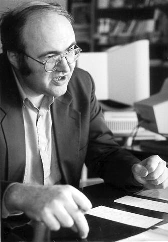 Jan Gruntorad, Ph.D., CESNet representative:
Jan Gruntorad, Ph.D., CESNet representative:


 Jan Gruntorad, Ph.D., CESNet representative:
Jan Gruntorad, Ph.D., CESNet representative:1994:
I would rate this year as a success one for CESNet. The following facts support my claim:
A. Last March, the team that has built CESNet was awarded the prize of the Minister of Education. As only three such prizes are awarded each year, it is a high appreciation for the 31-member team.
B. After two years of preparations, we persuaded the Internet Society(ISOC) and the Russeaux Associes pour la Recherche Europeenne (RARE), that we are able to support technically and organizationally their INET'94 and JENC5 conferences, held jointly in Prague in 1994.
C. The joint conference really took place in Prague last June. For this event, a 2Mbps fibre-optics line between Washington and Prague was maintained. In the context of this action, I also have to appreciate the effort of our PTT, which complied well with our needs in establishing the line. Also, a 512Kbps data circuit between Prague and Amsterdam was established for the needs of the conference. The line had to be cancelled after the conference and the original 64Kb/s line had to be used again. During the conference, it was demonstrated, that the Czech Republic is able to utilize the line fully even after the conference. The line was left in operation and the original slow line was cancelled. Moreover, the circuit was financed from PHARE resources till the end of October 1994. From November on, CESNet contributes by an agreed amount. Let us add for reader's information that the European Union proclaimed the PHARE program for 11 countries in duration of 2 years, with 4 million ECU for its operation.
D. We succeeded in gaining support from the Ministry of Education for the operation of CESNet and for development programs, financed by the Ministry's Universities Development Fund. An important task was the CESNet backbone reconfiguration project. Every town access point has been connected by at least two data circuits, achieving a degree of redundancy needed for improved reliability. Other important project comprised network services extension, in the first place GOPHER type services. The Technical University in Liberec is very active in this field, which stimulated upgrade of the connection to Liberec to 256 Kbp, much like the connection to Brno. The construction of PASNet (Prague Academic Network) backbone, a part of the CESNet, was a great success. At the end of 1994, following sites were connected using the ATM (Asynchronous Transfer Mode) technology and 155 Mbps speed: CVUT in Dejvice and in Nove Mesto, MFF UK in Karlin and in Mala Strana, VSE in Zizkov, and the Carolinum area.

These result show that we are able to keep pace with today's Internet trends. The Czech Republic not only gathers but also yields information. The international data circuits have almost balanced data input and output. Last but not least, I would appreciate the clarification of external relationships, that is, providing services outside the educational sector. Although the CESNet was originated to satisfy the needs of universities and research organizations, the high demand for these services forced the Ministry to provide CESNet services to other subjects, of course at defined terms.
1995:
I consider 1995 a key period for CESNet. The main task is to maintain the favourable course of development, which will be difficult.
Introduction of new applications, especially multimedia, causes significant increase of demands for data circuit capacity both inside the republic and internationally. The increase is exponential. It is a great progress that the Czech PTT (according to its statement) is able to realize data circuits with the necessary speed (from 2 Mb/s to 34Mb/s) within 1 or 1.5 year. Nevertheless, financing such circuits is a problem. The SPT TELECOM is under certain pressure form both the Ministry of Education and Ministry of Finances, which controls the financial policy of SPT TELECOM, pointing out that toll and international data circuit prices are extremely high in our republic. The first result is the SPT's announcement of 20% reduction in toll data circuit prices. A reduction in international data circuit prices, probably by 30%, has been promised. However, even with these reductions the data circuit prices are too high in comparison with other European countries. For example, in Austria, where the prices are approximately one half of SPT's prices, an overall decrease by 40% as was announced.
As the price of data circuits grows less than linearly with speed, which means that a data unit is transferred more cheaply over fast circuits, CESNet seeks partners to share at least fast international circuits. It succeeded with the Academy of Sciences, and negotiations with the cultural and health sectors and others are in progress.
The concept of information superhighway is not an invention of statesmen, it is a need with pragmatic evidence. Therefore, we want to focus on the most progressive applications, which we consider multimedia. As we plan to connect all bureaus of education (there are approx. 85 of them) to CESNet, we have to extend our nodes to sites where no university resides. We also must be prepared for transport of not only educational and research data, but of accounting and personal data as well, which requires higher level of security and reliability. CESNet plans to issue recommendations that the provider is responsible for the transport of data and the user has to provide reasonable security by means of appropriate methods of cryptography.


